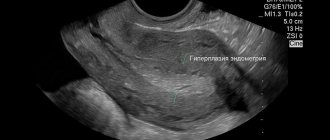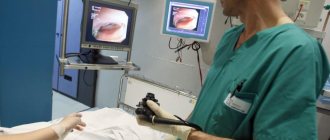Uterine polyps are a pathology of the endometrium in which foci of mucosal proliferation occur. Such formations have a variety of shapes (round, mushroom-shaped), can be on a thick or thin stalk, single or numerous, and the color varies from light pink to dark burgundy. Hormonal imbalance is the main cause of their occurrence.
The choice of method and treatment tactics for patients is influenced by various factors:
- Size of pathological formation;
- Structure;
- Age;
- Endometrial condition;
- Reasons for development;
- Presence of concomitant diseases.
The Yusupov Hospital is a leader in the treatment of uterine polyps; many years of experience working together with foreign clinics allows for surgical interventions of any level of complexity; thanks to innovative technologies, formations are removed as accurately and quickly as possible. Specialists from a leading Moscow clinic know all the methods for removing polyps in the uterus:
- Hysteroscopy followed by curettage of the cavity and cervix;
- Laser removal and separate diagnostic curettage;
- Minihysteroscopy.
Why do you need to remove polyps?
Such a growth on the endometrium is a benign tumor, but an anomaly, and therefore is not a sign of health of the reproductive system. Most often, formations are formed against the background of endocrine disorders, hyperplasia of the uterine mucosa or chronic inflammatory processes. Over time, the situation worsens and leads to serious complications:
- Insignificant in volume, but prolonged bleeding weakens the body, anemia occurs. The patient is pale, lethargic, absent-minded.
- Polyps often become damaged and become an open wound inside the uterus, in which pathogenic microorganisms can multiply and exist, leading to a chronic infectious process.
- Often growths on the endometrium become an obstacle to conception. A woman cannot become pregnant for a long time and upon examination a polyp is discovered inside the uterus. Gynecologists compare its effect with the effect of a contraceptive IUD.
- If fertilization does occur, the growth can cause miscarriage, hypoxia, embryo death, or significantly inhibit development.
- By enlarging and growing, polyps deform the endometrium and disrupt the normal functioning of the patient’s reproductive system, which can cause the appearance of other uterine pathologies.
- Formations of this type on the surface of the endometrium can eventually malignize and become an oncological tumor. Adenomatous polyps are most prone to malignancy, but such a complication cannot be excluded with other types of formations in the uterine cavity.
Carefully! Any polyp, from the point of view of medical science, is a precancerous condition.
In addition to these serious consequences, which occur over a long period of time, and even then not for everyone, the patient is tormented by symptoms of endometrial pathology:
- Menstruation lasts 7-8 days. With severe PMS, heavy discharge and pain;
- Contact bleeding during sex, which is also accompanied by pain;
- Brown or red spotting during menopause.
All this together is complemented by the lack of guaranteed effective medications against tumors. Therefore, gynecologists advise not to avoid removing the growth.
Is it possible not to remove polyps?
The patient has the right to write a refusal to undergo surgery, but in this case the doctors are relieved of responsibility for the consequences. Small single formations are relatively safe, without unpleasant symptoms, which regress under the influence of drug therapy.
The main questions that arise in the long-term period after polyp removal
When will your period start?
Despite the removal of the formation, the woman’s hormonal levels are not disturbed, therefore, menstruation after removal of the endometrial polyp occurs on time, only a slight deviation in the timing of the onset of menstruation is possible . Heavy periods are a variant of the normal course of the recovery period. However, if they develop into uterine bleeding, you should urgently consult a doctor.
When can you get pregnant?
Pregnancy after removal of an endometrial polyp can occur already in the current cycle if hormonal therapy is not started. However, this is not a completely favorable development of events, because the woman needs rehabilitation for a full recovery.
The optimal period for the inner layer of the uterus to completely recover is 3 months. It is for this period that combined oral contraceptives are prescribed. Their cancellation causes the so-called rebound effect, as a result of which the likelihood of pregnancy increases. If endometrial polyps were the cause of infertility, it is at this time that the most favorable moment for conception comes.
What treatment is prescribed after removal of an endometrial polyp?
The question of the advisability of prescribing hormonal drugs remains controversial. Some doctors believe that when removing a small polyp, drug therapy may not be necessary. Others argue that hormonal therapy is advisable because it helps restore normal endometrial function. Hormones are prescribed for functional glandular polyps, adenomatous formations, as well as for the combination of polyps with endometrial hyperplasia.
Combined oral contraceptives or progestogens (Duphaston) are usually prescribed. The choice of drug, its dosage and duration of administration is determined by the doctor. Usually it is 3 months. Often a woman is offered to install an intrauterine device containing levonorgestrel - Mirena. These measures, in addition to restoring endometrial function, are also aimed at planning pregnancy.
Clinical observation of a patient who has undergone polyp removal is carried out for a year.
Surgical methods for eliminating uterine endometrial polyps
There are several removal methods, each differing in complexity, recovery time, possible consequences and availability of equipment.
Scraping
In a public antenatal clinic in a small town, the patient will most likely be offered to remove a uterine polyp using this method. The procedure does not require special medical equipment and is available everywhere free of charge.
Based on diagnostic studies, the doctor will approximately determine the place of manipulation, and scrape off the endometrium in this area with a sharp instrument - a curette. Sometimes, just in case, the entire surface of the inner lining of the uterus is cleaned. Not only do the manipulations severely damage the tissue, careless movement can lead to a cut in the wall. The main disadvantage is low efficiency; in 80% of cases, relapse occurs due to remaining fragments of the polyp stalk.
Attention! In modern private clinics, curettage is used for diagnostic purposes to study the condition of the endometrium in the cervical canal and in the uterine cavity.
Vacuum aspiration
Another accessible and free method is when, to remove the formation, the entire endometrium is sucked out from the patient’s uterine cavity using a special device. The equipment is intended for early abortions. The method is much less damaging than scraping, but the effectiveness is similar.
Hysteroresectoscopy
The most modern, safe and effective method of surgical intervention for polyps inside the uterus. It is carried out in standard cases without complications on an outpatient basis, in the opposite situation in a hospital. Local anesthesia can be used for pain relief, but more often general anesthesia is used with a short duration of action.
Procedure for carrying out the procedure:
- Antiseptic treatment of the patient's genitals.
- Introduction of anesthesia.
- Installation of the cervical dilator.
- Placement of the tube through which various instruments will flow.
- Filling the uterus with a special solution to ensure constant circulation and correct pressure. Necessary for normal visibility and freedom of action.
- Introduction of camera with lighting.
- Detection of the polyp and evaluation of the entire endometrium.
- Supply of removal device.
- Division of the body and legs of the formation.
- Treatment of the wound.
- Re-examination of the surgical field.
- Removing tools.
- Washing the uterus with an antiseptic.
- Removing the expander.
- Sending the growth for histology.
- Placing the patient in the intensive care unit for several hours.
Hysteroresectoscopy can vary in the type of equipment used to remove the uterine polyp:
- Mechanical excision involves cutting off the formation and stripping the endometrium in this place;
- The use of an electrode will help separate the body of the polyp and seal the wound. Sometimes a combination with the previous method is used, when, after unscrewing or cutting off, the base is treated with current;
- Sometimes chemicals or liquid nitrogen are applied to remove the growth; this method is only suitable for small polyps.
Attention! The price for hysteroresectoscopy varies depending on the equipment, region, and medical institution. Minimum - 5-7 thousand rubles, maximum 30 or more.
Laser removal
A laser for eliminating growths in the uterine cavity is not available to every patient. The equipment is rare and expensive, but the technique has the best results. After the procedure, a scar does not even form, which is very important for patients who want to get pregnant. The cost including diagnosis and follow-up is tens of thousands of rubles.
How is the operation performed?
Polyp curettage and hysteroscopy in general have similarities.
In both cases, the woman is placed on a gynecological chair, she is given intravenous anesthesia, and as soon as the woman falls asleep, the doctor begins manipulation.
The procedure takes about 20 minutes . After which the intravenous anesthesia is stopped, and the woman awakens almost immediately.
In the first two hours after the intervention, dizziness is possible, so getting up, drinking and eating at this time is undesirable. After a few hours, all this is already possible, and if there are no complications, the patient is discharged home on the same day .
Indications and prohibitions
Surgery in the uterus is recommended in the following cases:
- The endometrial polyp belongs to the placental, adenomatous or glandular-fibrous type;
- The size of the formation reached 10-15 mm or more;
- Significant changes in the patient's menstrual cycle;
- Problems with conception;
- Constant bleeding;
- Age after 40;
- Rapid growth is a signal to undergo surgery urgently!
Attention! As a rule, pathology is rarely left under observation; doctors prefer to play it safe and remove the polyp right away.
Sometimes surgery is postponed for a while or not done at all under the following circumstances:
- Pregnancy up to 20 weeks;
- Period;
- Infection of the reproductive system in the acute phase;
- Colds and other general diseases as a result of the proliferation of microbes and viruses;
- Pathologies of vital organs with irreversible changes;
- Cervical cancer;
- Heavy bleeding.
Laser method
Refers to advanced and very effective methods for removing polyps in the uterus. This method involves the use of a laser beam.
The removal procedure is carried out layer by layer, all manipulations are clearly monitored on the monitor, so errors are excluded.
When removing polyps using a laser method, there is no risk of damage to healthy tissue, as well as infection of the wound surface after the intervention.
Usually the procedure lasts no more than half an hour, leaves no scarring effects, and does not affect future pregnancies.
It is possible to say that the uterus has recovered completely after removal only after six months or even more. Only after this period has passed can pregnancy planning begin. By this time, the hormonal status will also return to normal, since the course of hormone therapy to prevent relapses will be completed.
Usually, conception occurs safely within 2-3 months after stopping taking hormones.
Preparation for hysteroresectoscopy
Any operation is not carried out just like that and requires some preliminary measures.
Diagnostics
Such a procedure is a full-fledged surgical intervention, therefore, to assess the patient’s condition and the presence of contraindications, a number of studies required by the protocol are first carried out:
- Vaginal smear.
- Ultrasound of the uterus and other pelvic organs using access through the vagina.
- General and biochemical blood test;
- Standard tests for syphilis, hepatitis, HIV infection.
- Scraping from the cervix for cytology.
- Coagulogram.
- Therapist's report with cardiogram and fluorography, data on blood group and Rh factor.
Additionally, a consultation with an endocrinologist is often prescribed with tests for hormone levels.
Attention! The list of necessary studies for polyps may vary depending on the clinic and the individual condition of the patient.
Drug therapy
Endometrial pathology is first tried to be treated with hormones. Such measures can help reduce formation, and in isolated cases lead to complete resorption. For this purpose, oral contraceptives with a combination of estrogen and progesterone are used for young girls. For patients under 40 years of age, gestagens are used, and for older patients, sex hormone agonists are used. Throughout the entire period of treatment of formations, ultrasound is performed to assess the dynamics of the pathology. If medications do not produce any results, or progress in the growth of the endometrial polyp is noticeable, surgery is prescribed.
In addition, a course of antimicrobial therapy is necessary to get rid of the infection, which is a contraindication to surgery in the uterus. Combined antibacterial drugs in the form of vaginal suppositories are always used to sanitize the genital organs before the procedure.
Direct preparation of the patient for removal of polyps from the uterus
A few days before the date of the operation, the woman is recommended to follow some rules:
- Do not take blood thinning medications, such as acetylsalicylic acid;
- Do not use vaginal products on your own, including douching, tampons, suppositories;
- Abstain from sex for 3 days;
- Depilation of the intimate area;
- Do not eat or drink 12 hours before hysteroresectoscopy;
- Follow other instructions of the treating gynecologist.
On what days is the operation performed?
Due to the peculiarities of the functioning of the endometrium, which is shed during menstruation and grows until the next cycle, the procedure is best performed after menstruation and before ovulation.
Consequences of the techniques
Some patients, regardless of the method of polyp removal, be it laser therapy, curettage or hysteroscopic polypectomy, experience some postoperative consequences such as:
- Long-term delay of menstruation, when after removal there are no periods for more than 3 months;
- Discomfort and painful symptoms during sexual intercourse;
- Copious bloody discharge of a bright red hue. One pad only lasts for an hour. Oxytocin will help eliminate such bleeding.
- Development of infertility;
- Infectious lesions of the endometrium, which are characterized by hyperthermia (above 38°C), painful sensations in the abdomen and perineum. Such complications are typical for patients who have genitourinary infections before removal;
- In very rare cases, uterine perforation occurs, especially after blind curettage, hysteroscopy, etc.;
- Adhesions and scarring, which most often occur due to curettage. Cryodestruction and laser removal of polyps will help to avoid such complications;
- Hematometra - accumulation of blood inside the uterine body;
- Cancer processes. Usually occur in cases where adenomatous growths are not completely removed;
- Recurrence of polyposis - no method guarantees that the polyp will not appear again in the future.
Curettage, laser removal and other interventions can cause similar complications, but this happens infrequently. Much depends on the patients, how strictly they will follow medical recommendations.
Possible complications
Therapeutic hysteroscopy to remove growths is safe, but there is a possibility of negative consequences of the intervention:
- Infection - this outcome is prevented by antibacterial therapy before and after surgery, as well as by sterilization of instruments and treatment of the uterus with antiseptics during the procedure.
- Perforation is simply a hole in the wall. It is very dangerous. It happens due to medical error, inexperience, or incorrect equipment settings.
- Bleeding may develop several days after removal due to the patient's failure to comply with precautions.
- Reappearance of the polyp after weeks or months, otherwise – relapse of the pathology. The risk exists even when using modern methods of removing growths in the uterus, but it is much lower than with curettage.
Attention! Complications occur very rarely and are associated with the unprofessionalism of doctors and the patient’s failure to comply with recommendations.
When is curettage necessary?
to remove a polyp in any case, and curettage is one of the low-traumatic methods that is most often used by doctors .
However, curettage is not possible in all cases.
If the polyp is more than one cm in size, other methods of removing the tumor are used - cauterization, twisting, and so on..
Curettage is also not suitable for frequent relapses of the pathology, since in this case, in order to reduce the risk of developing cancer, complete removal of the uterus is recommended.
The procedure will not be particularly effective if a woman has aggravating factors - endocrine disorders, inflammation, etc. In all other cases, curettage is a reliable and low-traumatic method of getting rid of a polyp.
Expert opinion
Dmitrieva Elena Yurievna
Gynecologist-endocrinologist, 40 years of experience
The curettage process is the elimination of the neoplasm along with the internal mucosa of the reproductive organ. This method is advisable to use only for small tumors. Since access to the uterine cavity is possible through the cervical canal, curettage is considered a non-surgical method; the recovery period after such manipulation is short and not difficult. But still, complications and negative consequences after the intervention are possible, and in addition, after removing the polyp by curettage, some restrictions are imposed on the patient’s usual lifestyle for some time.
Rehabilitation
It takes a month or a little more for the endometrium to recover. During this period, sex, heavy exertion and vaginal products are prohibited, as well as immersion in water, hypothermia and overheating. After a week, and then two, a month, you need to undergo diagnostics to monitor the recovery of the uterus. Antibiotics are used in the first week to avoid infectious complications.
It is normal to have a slight brown spotting discharge for several days, as well as spasms and aching or cramping pain. The first menstruation will be insignificant in duration and volume, and then a normal cycle will be established.
Attention! It is not recommended to become pregnant before 5-6 months, or while undergoing additional courses of treatment.
Reviews from those who have undergone surgery
Alyona:
I am 32 years old. I decided to have a second child. During the examination, the ophthalmologist discovered a polyp of the uterine body. It was removed by hysteroscopy. Everything went without any problems. I am very happy because I will soon become a mother. There are a couple of months left before the birth. The polyp did not appear again.
Julia:
Back in 11, a polyp was discovered and removed with a laser; then this procedure was an innovation. I was very afraid that the polyp would come out again, but everything turned out okay. I see a gynecologist once every six months for prevention. So far there have been no relapses.
Maria:
I am 54 years old. The first polyp was removed almost 20 years ago. Then scraping was practiced, everyone removed it this way. After the first polyp there was a second one, only in a different place in the uterus, then a third, a fourth. Polyps were removed by curettage. As per schedule, a new polyp was discovered every two years, until it came to multiple polyposis with a high risk of malignancy. At 46, my uterus was removed. So curettage is a barbaric procedure.
How much will tumor excision cost?
In general, prices for procedures for removing polyp growths in the uterus are determined by the technique and level of the medical institution where the removal will be performed.
In Moscow clinics, the cost of surgery to remove polyps is approximately the following:
- Hysteroresectoscopy – 9,000-25,000 RUR;
- Laser removal – 11,000-36,000 RUR;
- Scraping – 5,000-7,500 RUR.
In regional clinics, prices for procedures are much lower; the exact cost should be found out directly at the medical institution.
Features of the procedure
Hysteroscope
Modern endoscopic equipment for this study allows you to visualize the internal state of the uterus. With its help, you can accurately localize pathological structures and remove them directly during manipulation.
Indications for manipulation:
- Diagnosis of benign neoplasms, fibroids, adenomyomas, endometrial polyps, diagnostic search and confirmation of the presence of malignant tumors.
- Bleeding from the uterus, the cause of which has not been established.
- Cleansing the uterine cavity from the remaining parts of the placenta.
- Infertility.
- Control of the treatment performed.
- Hormonal disorders.
Hysteroscopy is not performed in case of acute inflammatory process in the uterus, during pregnancy, acute respiratory infections or acute respiratory viral infections, exacerbation of somatic diseases, and also during critical days.
Surgery is performed both as a diagnostic and as a therapeutic measure.
Before hysteroscopy, an ultrasound examination of the uterus is often performed. An ultrasound scan is necessary to confirm the preliminary diagnosis and determine where the tumor is located. Ultrasound can also be done to monitor the treatment, as it helps to monitor how the endometrium has grown after a certain intervention.










